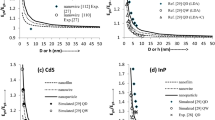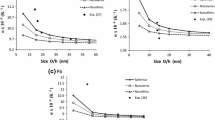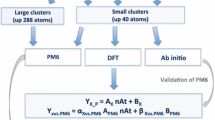Abstract
The present study is an effort to develop a simple analytical model without any adjustable parameter for observing the collective effect of size, dimension and shape on electrical susceptibility and dielectric constant of nanomaterials. The size dependence of electrical susceptibility and dielectric constant has been observed for some pure as well as binary semiconductor nanomaterials, in three different dimensions (i.e., nanoparticles, nanowires and nanofilms). It has been observed that the electrical susceptibility and dielectric constant both show reduction with the decrement in size, due to the increased surface-to-volume ratio and lower coordination number. The present study reveals that the difference between the values of electrical susceptibility of nanoparticles and nanowires (5–50%) is less in comparison with nanofilms (10–90%). This difference diminishes on moving toward the higher size range. The decrement in the value of dielectric constant with size is found, maximum for nanoparticles (10–80%) followed by nanowires (10–70%) and minimum in nanofilms (5–60%). The outcomes for the size-dependent dielectric constant have been compared with the available experimental and other theoretical data and found consistency in calculated results with experimental data. The model has been extended to investigate the cross-sectional shape effect along with size on the electrical susceptibility and dielectric constant of nanowires due to large applications by incorporating shape factor. Four different cross-sectional shapes: spherical, square, rectangular and hexagonal nanowires, have been taken for the present study. The calculated results of dielectric constant have been compared with the available experimental data, and close agreement was found. It has been observed that the electrical susceptibility and dielectric constant have the highest value for spherical cross-sectional-shaped nanowires and the lowest for rectangular cross-sectional-shaped nanowires. Deviation graphs show that the values of electrical susceptibility and dielectric constant for rectangular, square and hexagonal cross-sectional-shaped nanowires deviate from spherical nanowires as 2–14%, 2–4% and 1–2%, respectively. The present study confirms the importance of shape effect along with size and dimension for electrical properties of semiconductor nanomaterials.












Similar content being viewed by others
References
S. Muruganandam, G. Anbalagan, G. Murugadoss, Optical, electrochemical and thermal properties of Co2+-doped CdS nanoparticles using polyvinylpyrrolidone. Appl. Nanosci. 5, 245–253 (2015)
R. Rossetti, R. Hull, J.M. Gibson, L.E. Brus, Excited electronic states and optical spectra of ZnS and CdS crystallites in the 15–50 Å size range: evolution from molecular to bulk semiconducting properties. J Chem. Phys. 82, 552–559 (1985)
L.E. Brus, Electronic wave functions in semiconductor clusters: experiment and theory. J. Phys. Chem. 90, 2555–2560 (1986)
H. Hu, W. Zhang, Synthesis and properties of transition metals and rare-earth metals doped ZnS nanoparticles. J. Opt. Mater. 28, 536–550 (2006)
S. Coe, W.K. Woo, M.G. Bawendi, V. Bulovic, Electroluminescence from single monolayers of nanocrystals in molecular organic devices. Nature 420, 800–803 (2002)
W.V. Huynh, J.J. Dittmer, A.P. Alivisatos, Hybrid nanorod–polymer solar cells. Science 295(5564), 2425–2427 (2002)
X. Duan, F.Y. Huang, R. Agarwal, C.M. Lieber, Single-nanowire electrically driven lasers. Nature 421, 241–245 (2003)
H. Zhang, L.P. Wang, H.M. Xiong, L.H. Hu, B. Yang, W. Li, Hydrothermal synthesis for high quality CdTeQds. Adv. Mater. 15, 1712–1715 (2003)
K. Sato, Y. Tachibana, S. Hattori, T. Chiba, S. Kuwabata, Polyacrylic acid coating of highly luminescent CdSNanocrystalsfor biological labelling applications. J. Colloid Interface Sci. 324, 257–260 (2008)
L.K. Pan, C.Q. Sun, T.P. Chen, S. Li, C.M. Li, B.K. Tay, Dielectric suppression of nanosolid silicon. Nanotechnol 15(12), 1802–1806 (2004)
M. Li, J.C. Li, Q. Jiang, Size-dependent band-gap and dielectric constant of Si nanocrystals. Int. J. Mod. Phys. B. 24(15–16), 2297–2301 (2010)
M. Tian, M. Li, J.C. Li, Effect of size on dielectric constant for low dimension materials. Phys. B 406(3), 541–544 (2011)
M. Li, H. Li, Modeling dielectric constant of semiconductor nanocrystals. IEEE Trans. Nanotech. 11(5), 1004–1008 (2012)
H. Lu, X.K. Meng, Correlation between band gap, dielectric constant, Young’s modulus and melting temperature of GaN nanocrystals and their size and shape dependences. Sci. Rep. 5, 16939 (2015)
D.R. Penn, Wave-number-dependent dielectric function of semiconductors. Phys. Rev. 128(5), 2093–2097 (1962)
R. Tsu, D. Babić, Doping of a quantum dot. Appl. Phys. Lett. 64(14), 1806–1808 (1994)
W.H. Qi, B.Y. Huang, M.P. Wang, Z.M. Yin, J. Li, Shape factor for non-cylindrical nanowires. Phys. B Cond. Matter. 403(13–16), 2386–2389 (2008)
N. Arora, U. Pachauri, D.P. Joshi, Effect of cross-sectional shape on thermal conductivity of nanowires. J. Chem. Eng. Chem. Res. 3(11), 1022–1026 (2016)
N. Arora, D.P. Joshi, A theoretical approach to study the melting temperature of metallic nanowires. AIP Conf. Proc. 1731, 050054–1–050054-3 (2016)
Sun, C. Q., Sun, X. W., Tay, B. K., Lau, S. P., Chen, T. P., Huang, H. T. and Li, S. 2001. Dielectric suppression, blue-shift in photo luminescence and absorption of nanometric semiconductors. Technical Digest. CLEO/Pacific Rim 2001. In: 4th Pacific Rim conference on lasers and electro-optics (Cat. No.01TH8557)
X.Y. Lang, W.T. Zheng, Q. Jiang, Finite size effect on band structure and photoluminescence of semiconductor nanocrystals. IEEE Trans. Nanotech. 7(1), 5–9 (2008)
J.H. Rose, J. Ferrante, J.R. Smith, Universal binding energy curves for metals and bimetallic interfaces. Phys. Rev. Lett. 47, 675–678 (1981)
K.F. Brennan, E. Bellotti, M. Farahmand, J. Haralson, P.P. Ruden, J.D. Albrecht, A. Sutandi, Materials theory based modeling of wide band gap semiconductors: from basic properties to devices. Sol.-Stat. Electron. 44(2), 195–204 (2000)
Sapra, S., and Sarma, D. D. 2004. Evolution of the electronic structure with size in II–VI semiconductor nanocrystals. Phys. Rev. B. 69(12)
A.L. Efros, A.L. Efros, Interband light absorption in semiconductor spheres. Sov. Phys. Semiconductor. 16(7), 772–775 (1982)
N. Arora, D.P. Joshi, Band gap dependence of semiconducting nano-wires on cross-sectional shape and size. Int. J. Phys. 91(12), 1493–1501 (2017)
Q. Jiang, H.X. Shi, M. Zhao, Melting thermodynamics of organic nanocrystals. J. Chem. Phys. 111(5), 2176–2180 (1999)
S. Suresh, Semiconductor nanomaterials, methods and applications: a review. Nanosci. Nanotech. 3(3), 62–74 (2013)
M.K. Sahu, Semiconductor nanoparticles theory and applications. Int. J. Appl. Eng. Res. 14(2), 491–494 (2019)
T.P. Chen, Y. Liu, M.S. Tse, O.K. Tan, P.F. Ho, K.Y. Liu, A.L.K. Tan, Dielectric functions of si nanocrystals embedded in a SiO2 matrix. Phys. Rev. B. 68(15), 153301 (2003)
Y. Yang, W. Guo, X. Wang, Z. Wang, J. Qi, Y. Zhang, Size dependence of dielectric constant in a single pencil-like ZnO nanowire. Nano Lett. 12(4), 1919–1922 (2012)
S. Suresh, Studies on the dielectric properties of CdS nanoparticles. App. Nanosci. 4(3), 325–329 (2013)
R. Tsu, D. Babić, L. Ioriatti, Simple model for the dielectric constant of nanoscale silicon particle. J. Appl. Phys. 82(3), 1327–1329 (1997)
A.C. Sharma, Size-dependent energy band gap and dielectric constant within the generalized pennmodel applied to a semiconductor nanocrystallite. J. Appl. Phys. 100, 84301 (2006)
H. Jiang, Y. Su, J. Zhu, H. Lu, X.K. Meng, Piezoelectric and pyroelectric properties of intrinsic GaN nanowires and nanotubes: size and shape effects. Nano. Energy. 45, 359–367 (2018)
M. Li, J.C. Li, Size effects on the band-gap of semiconductor compounds. Mater. Lett. 60, 2526–2529 (2006)
Author information
Authors and Affiliations
Corresponding author
Additional information
Publisher's Note
Springer Nature remains neutral with regard to jurisdictional claims in published maps and institutional affiliations.
Rights and permissions
About this article
Cite this article
Pachauri, U., Joshi, D.P. & Arora, N. Theoretical model for size, dimension and shape effect on electrical behavior of semiconductor nanomaterials. Appl. Phys. A 126, 253 (2020). https://doi.org/10.1007/s00339-020-3411-1
Received:
Accepted:
Published:
DOI: https://doi.org/10.1007/s00339-020-3411-1




